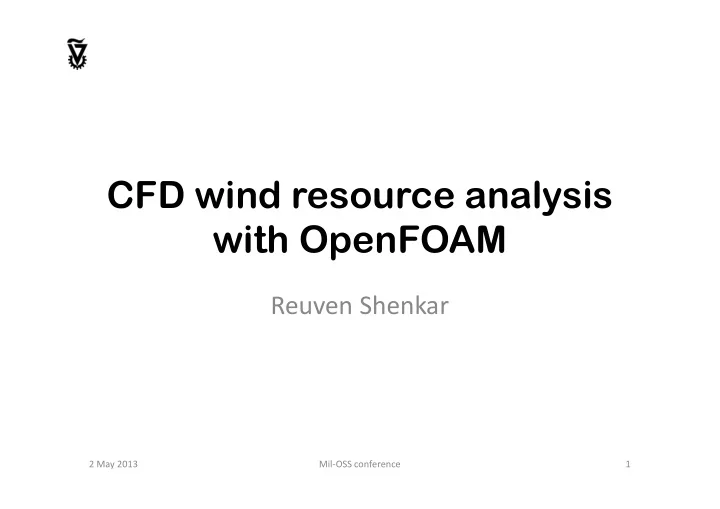

CFD wind resource analysis with OpenFOAM Reuven Shenkar 2 May 2013 Mil-OSS conference 1
Motivation • Wind resource analysis for wind energy applications • Complex terrain induces nonlinear effects � Linear models fail • Ever-increasing trend towards CFD � Also an increasing need to study turbulence 2 May 2013 Mil-OSS conference 2
CFD for wind resource • Atmospheric boundary layer � Incompressible flow � Neglect gravity* � Neglect Coriolis RANS � Neglect humidity, cloud physics, radiation, aerosols, etc… � Do NOT neglect thermal effects = atm. stability 2 May 2013 Mil-OSS conference 3
Commercial CFD wind resource codes • Dedicated codes � WindSim � Meteodyn � Ventos source: www.meteodyn.com � … • General purpose source: www.windsim.com � Fluent � CFX source: www.ansys.com � … 2 May 2013 Mil-OSS conference 4
OpenFOAM – pros & cons • Advantages � It’s free! � Can run as many cores as you have, no per-core fees � Not a black box – full control of the code 2 May 2013 Mil-OSS conference 5
OpenFOAM – pros & cons (cont’d) • Disadvantages � Long and steep learning curve � Low productivity � Could have been faster � Not easy to get support � Bugs – especially in esoteric applications • However… an ever expanding worldwide users community (also wind) � Also quite a few commercial vendors offer extensions, training, support etc. 2 May 2013 Mil-OSS conference 6
OpenFOAM applications 2 May 2013 Mil-OSS conference 7
OpenFOAM basics • OpenFOAM � Meshing (blockMesh, snappyHexMesh) � Solvers � Postprocessing (paraView & other utilities) • Extensions � Open source wrapper scripts (e.g. pyFoam) � Commercial GUI available out there 2 May 2013 Mil-OSS conference 8
Setting up a wind resource analysis case • Digital Elevation Model mesh • Roughness model boundary • Wind data* conditions • Stability parameters* source: CFD simulation of the atmospheric boundary layer: wall function problems, Blocken et al. (2007) http://dx.doi.org/10.1016/j.atmosenv.2006.08.019 2 May 2013 Mil-OSS conference 9
Validation cases • Askervein Hill • Bolund source: www.yorku.ca source: www.yorku.ca 2 May 2013 Mil-OSS conference 10
Meshing • Pointwise • snappyHexMesh 2 May 2013 Mil-OSS conference 11
Results • <mention performance – run times> 2 May 2013 Mil-OSS conference 12
Results (cont’d) 2 May 2013 Mil-OSS conference 13
Challenges • Inserting met mast measurements as a point “boundary condition” • Atmospheric stability • ABL boundary conditions & turbulence modeling – still an open issue (like turbulence itself…) 2 May 2013 Mil-OSS conference 14
Summary • OpenFOAM: • This, however, comes at a price • Test per-application first • Expect good/fair performance in common applications; expect trouble in esoteric applications • So far encouraging results 2 May 2013 Mil-OSS conference 15
Thanks for listening reuven.shenkar@rsengineering.co.il 2 May 2013 Mil-OSS conference 16
Hardware and software • Binaries for Ubuntu, SuSE, Fedora www.openfoam.com/www.openfoam.org � Otherwise get source and compile • PC � I7-3930K (dual socket Xeon = better) � Fast RAM, and lots of it (> 32 GB recommended) 2 May 2013 Mil-OSS conference 17
Recommend
More recommend